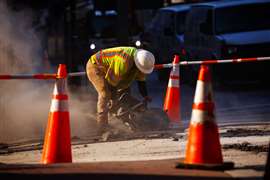Explainer: What is the Davis-Bacon Act and how is it changing?
07 September 2023
Last month saw the US Department of Labor (DOL) issue a major update to labour regulations in construction that impacts employers and employees alike. The changes update the regulations that implement the Davis-Bacon Act and apply to federal and federally assisted construction projects.
In this explainer, legal experts Peter Crofton and Yash Dave explain what the Davis-Bacon Act is, why the changes could result in better wages for workers but could carry less positive consequences too, and how the updates also hand employees more tools to fight retaliation from employers.
 Image: Sergey Novikov via AdobeStock - stock.adobe.com
Image: Sergey Novikov via AdobeStock - stock.adobe.com
The US Department of Labor (DOL) recently issued its Final Rules updating certain requirements under the Davis-Bacon Act relating to the payment of workers on federally funded construction projects.
Known as “prevailing wages,” the Davis-Bacon Act requires employers to pay wages and benefits determined by the DOL to be appropriate for specific job classifications within defined geographic areas.
The Davis-Bacon Act is a Depression-era law intended to protect local jobs.
The Act protected local construction companies and their workers from being under-bid by non-local companies that sought to utilize non-local workers who were paid a lower wage.
By requiring all contractors to pay the wage rates prevalent in the local area, non-local contractors would not have a competitive advantage over local companies.
How the Davis-Bacon Act worked previously
After the passage of the Davis-Bacon Act, the DOL applied the “30%” rule to determine prevailing wages, including benefits. Under that
 Peter Crofton
Peter Crofton
rule, the DOL first attempted to find a wage rate including benefits paid to the majority of workers in that job classification in that area.
If the DOL could not find a majority wage rate, then it would use the wage rate paid to 30% of workers.
If the DOL could not find a wage paid to 30% of workers, then the Department would use a weighted average of the wage rates to establish the required prevailing wage rate paid on federally funded construction projects.
In response to criticism that Davis-Bacon wage rates were too high thereby driving up the cost of government funded construction projects, in 1983 the DOL stopped using the 30% rule.
Instead, the Department used a weighted average to determine wage rates whenever a rate that was paid to the majority of workers in a job classification in a geographic area could not be found.
The Final Rules revive the 30% rule.
As explained in the White House’s Fact Sheet on the Final Rules, the intent of reviving the 30% rule is to “raise wage standards of construction workers by updating prevailing wage regulations...”
The White House further explained that changing how prevailing wage rates are determined is expected to put “thousands of extra dollars per year in workers’ pockets to help put a down payment on a home, save for retirement, or simply have more breathing room.”
The Final Rules take effect 60 days after issuance, and are expected to have an immediate impact on new construction projects that are totally or partially funded with federal money.
Higher wages can attract additional workers to the job market, helping to alleviate the construction labor shortage, especially in skilled trades.
Higher wages also create ripple effects in the economy as workers have more money to spend on goods and services.
They can help offset the effect of inflation and other price impacts that have impacted consumer prices for everything from food and gas to back-to-school supplies.
‘Not all Final Rules changes will be positive’
However, not all of the impact of the Final Rules will be positive.
The Biden Administration has made improving infrastructure a centerpiece of its economic policy, including transportation and clean energy infrastructure.
The Administration increased spending in a variety of programs that are funded, directly or indirectly, with federal money.
All of these programs that involve construction will potentially see higher costs, and as a result, deliver fewer projects for the allocated money.
An example of the impact of higher prevailing wages is the Infrastructure Investment and Jobs Act (IIJA).
Under the Act, the federal government is estimated to spend over $1 trillion on infrastructure-related projects, some of which will be spent in conjunction with state and local governments via federal-aid project funding.
The Administration boasts that it has already allocated over $220 billion dollars in funding under the IIJA for over 32,000 specific infrastructure projects.
The Final Rules, which are specifically intended to increase wage rates on federally funded construction projects, will raise labor costs on all or substantially all new IIJA-funded projects.
Consequently, construction costs are virtually certain to increase because of the Final Rules, and the number of infrastructure improvements that can be completed without additional funding will correspondingly decrease.
The Final Rules will impact construction around the country for many years to come.
The positive and negative effects of the Final Rules will be studied by proponents and opponents alike.
It remains to be seen if future administrations will rescind the Final Rules, or if this will truly be the final word on Davis-Bacon wage rate determinations.
New anti-retaliation measures
In addition to the increased wages for workers, the Final Rules will impact how Davis-Bacon Act related retaliation claims are
 Yash Dave
Yash Dave
investigated and adjudicated.
Specifically, the Final Rules include a new anti-retaliation contract clause, adds anti-retaliation information to the Davis-Bacon workplace poster, and expands the remedies available to workers who believe they were retaliated against for reporting actual or suspected violations of the Act.
These new notices and remedies may cause more workers to come forward and report suspected violations resulting in an increase of DOL investigations and costs to employers.
The Final Rules propose a new anti-retaliation contract clause that must be included in any federal construction contract subject to the Act.
The new clause states it is unlawful for any person to discharge, demote, intimidate, threaten, restrain, coerce, blacklist, harass, or in any other manner discriminate, or cause any person to do the same, against any worker for engaging in protected activities.
Protected activities include notifying a contractor of any conduct the worker reasonably believes constitutes a violation of the Act, filing a complaint, initiating a proceeding, asserting any right or protection, cooperating in an investigation, testifying in any proceeding, or informing others about their rights under the Act.
The new anti-retaliation clause is intended to discourage contractors from engaging in any conduct that may chill a worker’s complaints about violations of the Act or participation in a DOL investigation regarding prevailing wage violation.
The DOL also intends to include anti-retaliation information in the Davis-Bacon workplace poster.
Employers performing work covered the Act is required to display the poster (including any applicable wage determination) at the site of the work in a prominent and accessible place where it may be easily seen by workers.
The current poster, which is available on the DOL’s website, contains information about prevailing wages, overtime compensation, enforcement obligations, and contact information for the government agency’s contracting offer. The new poster will include the anti-retaliation information contained in the contract clause referenced above, thereby informing employees of the protections available under the Act.
Remedies for retaliation expanded
The Final Rules also expand the remedies the DOL may order if a contractor retaliates against workers.
Under the current framework, the DOL could debar contractors from federal contracts and award back wages to workers for violations of the Act, but it could not award other remedies.
The Final Rules expand the available remedies the DOL may award to include, but are not limited to, award of back wages and benefits, compensatory damages or other actual monetary loses, interest on monetary relief, and equitable relief such as reinstatement or front pay, expungement of warnings, reprimands, or derogatory references, and the provision of a neutral employment reference.
The DOL contends workers are often reluctant to report suspected violations and cooperate in investigations because they fear losing their jobs or suffering other adverse employment actions.
These expanded remedies are, therefore, intended to encourage more workers to report actual or suspected violations, cooperate with DOL investigations, and ensure that workers are made whole after suffering reprisals as a result of such reporting.
However, existing federal laws already encourage workers to report violations and provide for the type of remedies proposed in the Final Rules.
Workers could pursue such retaliation claims under other federal statutes that provide for whistleblower protection for employees of federal contractor. For example, 41 U.S.C. § 4712 prohibits a federal contractor from discharging, demoting, or otherwise discriminating against an employee for making a protected whistleblower disclosure.
Workers who believe they were retaliated against for making a protected disclosure could file a complaint with the Office of Inspector General (OIG). The OIG is authorized to investigate such complaints and submit a report to the executive agency involved, which is then authorized to award the complainant compensatory damages, back pay, employment benefits, reinstatement or front pay, attorneys’ fees and costs, and “other terms and conditions of employment that would apply to the [worker] in that position if the reprisal had not been taken.”
Similar whistleblower protection statutes exist for workers of certain Department of Defense contractors as well.
The expanded anti-retaliation remedies may, therefore, duplicate existing protections available to workers.
Some workers may elect to take advantage of the multiple avenues by filing complaints with multiple government agencies resulting in duplicate investigations and costs.
The Final Rules may very well succeed in encouraging more workers to report suspected violations, but may increase cost on employers as well and result in increased employment litigation.
Peter Crofton is a partner and the Atlanta section head of the construction law practice at Smith, Gambrell & Russell. Yash Dave is a partner in the firm’s litigation practice with a focus on labor & employment litigation.



